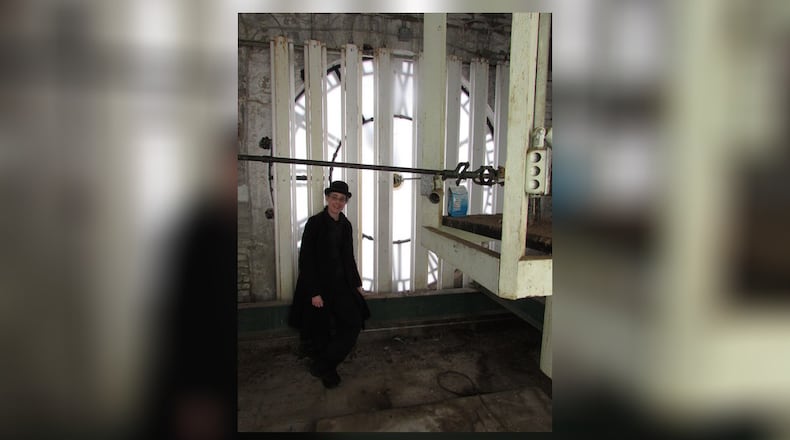I’ve previously stayed up late watching a movie and witnessed the sudden switch to or from Daylight Savings. It’s magic, I think.
RELATED: Cottrel: New Carlisle church has best fish fry
However, the clock in the car, wrist watches and wall clocks will drive us crazy for weeks as we search for instructions, or drag in a step ladder to reach the clock to change the time.
There’s one location in Springfield that takes major effort twice a year to change the time and that is the clock in the tower of the Heritage Center of Clark County.
High over Springfield, the four clock faces on the tower; north, south, east and west, can be seen for miles. This is Springfield’s most visible clock and it must be changed manually, as it was when it was made more than 100 years ago.
Updating the clock is the job of Kasey Eichensehr, a curator at the Clark County Historical Society at the Heritage Center, and she loves it.
Eichensehr was a student at Wittenberg University working at the Heritage Center just before it opened in when she first climbed the clock tower to watch Chief Executive Officer Roger Sherrock update the clock.
“First time I did this, I said, ‘This is my job now,’” said Kasey, who graduated from Wittenberg with a degree in literature but went on to Wright State to earn a Master’s degree in public history. She’s now a full-time employee of the Heritage Center.
DETAILS: Maple tapping a sign spring isn’t far off in Clark County
“The first time I looked over my shoulder and saw the hands moving, I was thrilled,” she said.
I was excited to get the opportunity to go along with her last weekend. Even though I wondered how I would do with all those steps. Luckily the first three floors were by elevator, which got us almost half way up there.
After going through a series of locked doors, we climbed into the actual tower, which had a wooden stairway that followed the inside of the tower’s walls. We climbed through a series of rooms, each level with a little more bird droppings than the one before and a better view out the small windows.
Kasey pointed out the bird stress call that had been installed to scare the crows off the building. As she explained, the crows quickly got used to it. I imagine that now it only scares visitors who think birds are attacking. I know it scared me the first time I heard it and it was loud up in the tower.
By the time we got to the clock level, the wooden stairs were narrower and older. I didn’t even ask to take the final tall ladder through a hatch to the bell tower.
READ MORE: Cottrel: Signs reveal Enon history to newcomers
The clock level is brightly lit. The clock faces are like large round translucent windows with a circle of numerals. I could only see the clock hands on the east-facing window because the sun was shining through it.
The hands of all four clock faces are connected by lengthy rods to a complex gear combination that is linked to the clock apparatus, secure in its own closet.
Kasey opened the clock cabinet door and immediately began her adjustments. The clock’s inner workings are beautiful — made of shiny brass and totally free of cobwebs, dust or droppings. It is difficult to believe that it’s over a century old. The clock was installed then reconfigured nearly a century later for the big opening of the museum. It looks like it was made last week.
Adjusting the gears that control the hands of the clock takes strength, dexterity and balance as Kasey had to stand on the beams that support the cabinet and reach into the mechanism. I could tell she was engrossed in her work.
She asked me to look at her cell phone and tell her the exact time.
MORE COVERAGE: Stampeding squirrels once overran Ohio, damaging crops
Then I watched the gears move and the hands progress to the next hour as the time sprung forward.
I must admit it was really cool.
Kasey was almost poetic about it.
“It’s an unreal feeling,” she said. “Thrusting my hands into the mechanism of time.”
She explained that “Springing Forward” is a bit easier than “Falling Back.”
“It is especially epic when I’m turning time back,” Kasey said.
I agreed, imagining that turning back time is really sweet for a historian.
Sadly it was time to head back to the normal world. I must report that I didn’t see any Quasimodo-type characters or any bats in the belfry.
On the way back down, Kasey asked me to personally thank those who voted for the historical society levy last fall.
“Getting that levy passed was heartening,” she said. “Knowing that what we do matters that much to everyone lifted our spirits.”
I must say that my spirits were lifted by this whole process. It made “Spring Forward” an adventure.
Kasey also told me that she would love to know how many people look at this clock tower on a daily basis.
She got her first answer when we got back into the main building, and a Clark State student, Priscilla Finchum, told us that from the parking lot, she had watched the clock hands move forward. Cool.
I know there has to be thousands more. Enjoy the clock tower, folks, but remember to keep your eyes on the road!
About the Author
